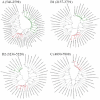Variability of HIV-1 genomes among children and adolescents from São Paulo, Brazil
- PMID: 23667488
- PMCID: PMC3646872
- DOI: 10.1371/journal.pone.0062552
Variability of HIV-1 genomes among children and adolescents from São Paulo, Brazil
Abstract
Background: Genetic variability is a major feature of the human immunodeficiency virus type 1 (HIV-1) and considered the key factor to frustrating efforts to halt the virus epidemic. In this study, we aimed to investigate the genetic variability of HIV-1 strains among children and adolescents born from 1992 to 2009 in the state of Sao Paulo, Brazil.
Methodology: Plasma and peripheral blood mononuclear cells (PBMC) were collected from 51 HIV-1-positive children and adolescents on ART followed between September 1992 and July 2009. After extraction, the genetic materials were used in a polymerase chain reaction (PCR) to amplify the viral near full length genomes (NFLGs) from 5 overlapped fragments. NFLGs and partial amplicons were directly sequenced and data were phylogenetically inferred.
Results: Of the 51 samples studied, the NFLGs and partial fragments of HIV-1 from 42 PBMCs and 25 plasma were successfully subtyped. Results based on proviral DNA revealed that 22 (52.4%) patients were infected with subtype B, 16 (38.1%) were infected with BF1 mosaic variants and 4 (9.5%) were infected with sub-subtype F1. All the BF1 recombinants were unique and distinct from any previously identified unique or circulating recombinant forms in South America. Evidence of dual infections was detected in 3 patients coinfected with the same or distinct HIV-1 subtypes. Ten of the 31 (32.2%) and 12 of the 21 (57.1%) subjects with recovered proviral and plasma, respectively, protease sequences were infected with major mutants resistant to protease inhibitors. The V3 sequences of 14 patients with available sequences from PBMC/or plasma were predicted to be R5-tropic virus except for two patients who harbored an X4 strain.
Conclusions: The high proportion of HIV-1 BF1 recombinant, coinfection rate and vertical transmission in Brazil merits urgent attention and effective measures to reduce the transmission of HIV among spouses and sex partners.
Conflict of interest statement
Figures






Similar articles
-
Deep sequencing of HIV-1 near full-length proviral genomes identifies high rates of BF1 recombinants including two novel circulating recombinant forms (CRF) 70_BF1 and a disseminating 71_BF1 among blood donors in Pernambuco, Brazil.PLoS One. 2014 Nov 17;9(11):e112674. doi: 10.1371/journal.pone.0112674. eCollection 2014. PLoS One. 2014. PMID: 25401747 Free PMC article.
-
Characterization of partial and near full-length genomes of HIV-1 strains sampled from recently infected individuals in São Paulo, Brazil.PLoS One. 2011;6(10):e25869. doi: 10.1371/journal.pone.0025869. Epub 2011 Oct 14. PLoS One. 2011. PMID: 22022460 Free PMC article.
-
Ultra-Deep Sequencing of HIV-1 near Full-Length and Partial Proviral Genomes Reveals High Genetic Diversity among Brazilian Blood Donors.PLoS One. 2016 Mar 31;11(3):e0152499. doi: 10.1371/journal.pone.0152499. eCollection 2016. PLoS One. 2016. PMID: 27031505 Free PMC article.
-
Characterization and frequency of a newly identified HIV-1 BF1 intersubtype circulating recombinant form in São Paulo, Brazil.Virol J. 2010 Apr 16;7:74. doi: 10.1186/1743-422X-7-74. Virol J. 2010. PMID: 20398371 Free PMC article.
-
HIV-1 subtype C predicted co-receptor tropism in Africa: an individual sequence level meta-analysis.AIDS Res Ther. 2020 Feb 7;17(1):5. doi: 10.1186/s12981-020-0263-x. AIDS Res Ther. 2020. PMID: 32033571 Free PMC article. Review.
Cited by
-
Enhanced detection of viral diversity using partial and near full-length genomes of human immunodeficiency virus Type 1 provirus deep sequencing data from recently infected donors at four blood centers in Brazil.Transfusion. 2015 May;55(5):980-90. doi: 10.1111/trf.12936. Epub 2014 Nov 21. Transfusion. 2015. PMID: 25413141 Free PMC article.
-
HIV-1C proviral DNA for detection of drug resistance mutations.PLoS One. 2018 Oct 4;13(10):e0205119. doi: 10.1371/journal.pone.0205119. eCollection 2018. PLoS One. 2018. PMID: 30286160 Free PMC article.
-
Deep sequencing of HIV-1 near full-length proviral genomes identifies high rates of BF1 recombinants including two novel circulating recombinant forms (CRF) 70_BF1 and a disseminating 71_BF1 among blood donors in Pernambuco, Brazil.PLoS One. 2014 Nov 17;9(11):e112674. doi: 10.1371/journal.pone.0112674. eCollection 2014. PLoS One. 2014. PMID: 25401747 Free PMC article.
-
Molecular Characterization of the Human Immunodeficiency Virus Type 1 in Women and Their Vertically Infected Children.AIDS Res Hum Retroviruses. 2015 Oct;31(10):1046-51. doi: 10.1089/AID.2015.0166. AIDS Res Hum Retroviruses. 2015. PMID: 26200738 Free PMC article.
-
Estimating HIV-1 Genetic Diversity in Brazil Through Next-Generation Sequencing.Front Microbiol. 2019 Apr 9;10:749. doi: 10.3389/fmicb.2019.00749. eCollection 2019. Front Microbiol. 2019. PMID: 31024510 Free PMC article.
References
-
- Peters V, Liu KL, Dominguez K, Frederick T, Melville S, et al. (2003) Missed opportunities for perinatal HIV prevention among HIV-exposed infants born 1996–2000, pediatric spectrum of HIV disease cohort. Pediatrics 111: 1186–1191. - PubMed
-
- Sperling RS, Shapiro DE, Coombs RW, Todd JA, Herman SA, et al. (1996) Maternal viral load, zidovudine treatment, and the risk of transmission of human immunodeficiency virus type 1 from mother to infant. Pediatric AIDS Clinical Trials Group Protocol 076 Study Group. N Engl J Med 335: 1621–1629. - PubMed
-
- Pitt J, Brambilla D, Reichelderfer P, Landay A, McIntosh K, et al. (1997) Maternal immunologic and virologic risk factors for infant human immunodeficiency virus type 1 infection: findings from the Women and Infants Transmission Study. J Infect Dis 175: 567–575. - PubMed
Publication types
MeSH terms
Grants and funding
LinkOut - more resources
Full Text Sources
Other Literature Sources

